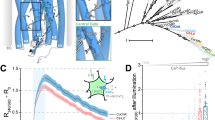Abstract
‘Calcium-antagonists’ are a group of pharmacological agents which are potent vasodilators and are clinically used for the treatment of angina. They are thought to block Ca2+ channels in vascular smooth muscle1,2 and myocardium3–5 but other sites of action have been proposed6. These agents bind tightly to heart muscle and suppress action potential and contraction. Nifedipine and nisoldipine (BAY K 5552) are Ca2+ antagonists which have o-nitrobenzyl groups and are photolabile7. We have found that short pulses of UV light rapidly inactivate these drugs in ventricular muscle. This observation allowed us to study the effect of Ca2+ antagonists on action potential, Ca2+ current and tension in conditions in which diffusion of those drugs from their site of action was not rate limiting. Our studies, described here, suggest that the primary mechanism of action of Ca2+ antagonists is the blockade of the Ca2+ channel and support the idea that extracellular space is the immediate source of contractile Ca2+ in the frog heart.
This is a preview of subscription content, access via your institution
Access options
Subscribe to this journal
Receive 51 print issues and online access
$199.00 per year
only $3.90 per issue
Buy this article
- Purchase on Springer Link
- Instant access to full article PDF
Prices may be subject to local taxes which are calculated during checkout
Similar content being viewed by others
References
Bolton, T. B. Physiol. Rev. 59, 606–718 (1979).
Meisheri, K. D., Hwang, O. & Van Breeman, C. J. Membrane Biol. 59, 19–25 (1981).
Coraboeuf, E. The Slow Inward Current and Cardiac Arrhythmias, Ch. 3 (Martinus Nijhoff, Boston, 1980).
Henry, P. D. Am J. Cardiol. 46, 1047–1058 (1980).
Fleckenstein, A. New Perspectives on Calcium Antagonists, Ch. 5 (Williams & Wilkins, Baltimore, 1981).
Millard, R. W. et al. Am. J. Cardiol. 49, 499–506 (1982).
Schlossmann, V. K. Arzneim.-Forsch. (Drug Res.) 22, 60–62 (1972).
Morad, M. & Orkand, R. J. Physiol., Lond. 219, 167–189 (1971).
Morad, M. & Goldman, Y. Prog. Biophys. molec. Biol. 27, 257–313 (1973).
Goldman, Y. & Morad, M. J. Physiol., Lond. 268, 613–654 (1977).
Morrison, H. A. The Chemistry of the Nitro and Nitroso Groups Pt 1 (ed. Feuer, H.) 165–213 (Wiley, New York, 1969).
Kaplan, J. H., Forbush, B. III & Hoffman, J. F. Biochemistry 17, 1929–1935 (1978).
McCray, J. A., Herbette, L., Kihara, T. & Trentham, D. R. Proc. natn. Acad. Sci. U.S.A. 77, 7237–7241 (1980).
Morad, M. & Klitzner, T. Biophysical Aspects of Cardiac Muscle (ed. Morad, M.) 1227–1243 (Academic, New York, 1978).
Kohlhardt, M., Bauer, B., Krause, A. & Fleckenstein, A. Pflügers Arch. ges. Physiol. 338, 115–123 (1973).
Kohlhardt, M., Mnich, Z. & Haap, K. J. molec. cell. Cardiol. 11, 1227–1243 (1979).
Babskii, E. B. & Donskikh, E. A. Doklady Akademii Naak. SSSK 178, 248–251 (1968).
Morad, M., Tung, L. & Greenspan, A. M. Am. J. Cardiol. 49, 595–601 (1982).
Ishizuka, T. & Endo, M. Circulation Res. 52, Suppl. 1, 110–114 (1983).
Nayler, W. G. & Grinwald, P. Fedn Proc. 40, 2855–2861 (1981).
Author information
Authors and Affiliations
Rights and permissions
About this article
Cite this article
Morad, M., Goldman, Y. & Trentham, D. Rapid photochemical inactivation of Ca2+-antagonists shows that Ca2+ entry directly activates contraction in frog heart. Nature 304, 635–638 (1983). https://doi.org/10.1038/304635a0
Received:
Accepted:
Issue Date:
DOI: https://doi.org/10.1038/304635a0
This article is cited by
-
A remote control for switching
Nature Chemical Biology (2018)
-
Optical control of L-type Ca2+ channels using a diltiazem photoswitch
Nature Chemical Biology (2018)
-
A one-pot four-component reaction providing quinoline-based 1,4-dihydropyridines
Journal of the Iranian Chemical Society (2015)
-
Inhibitory effect of calcium channel blockers on human mesangial cell growth: Evidence for actions independent of L-type Ca2+ channels
Kidney International (1996)
-
Effect of extracellular calcium on the contractility of warm-and cold-acclimated crucian carp heart
Journal of Comparative Physiology B (1996)
Comments
By submitting a comment you agree to abide by our Terms and Community Guidelines. If you find something abusive or that does not comply with our terms or guidelines please flag it as inappropriate.



